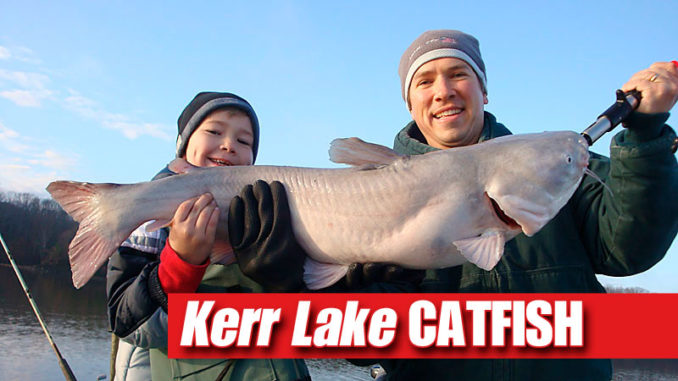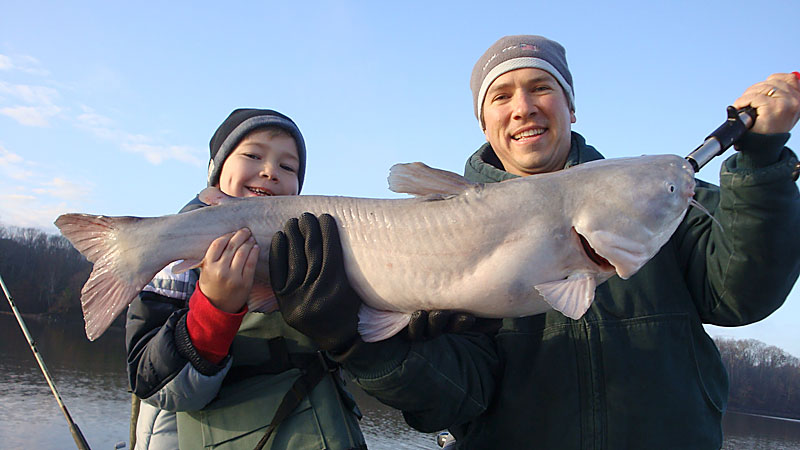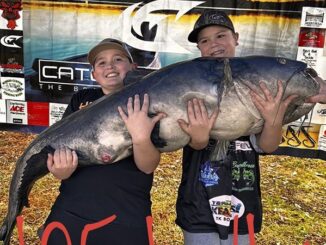
Fewer fish, but bigger ones too
Guide Chris Bullock said you won’t catch many Kerr Lake catfish in January. But the ones you do catch will have some bulk to them.
“Heavy blues are like heavy people,” said Bullock (www.kerrcrappieandcats.com). “They’ve got to keep eating to keep their figures. They can’t go days without dining like smaller catfish. That’s why smaller blues are difficult to catch in the winter. They can go weeks without eating.”
For big blues, Bullock, who is from Fountain, N.C., uses big tackle. He mounts 15 to 16 Shakespeare 7-foot Ugly Stik baitcasting and spinning rods designed for catfishing around his pontoon boat. The baitcasting rods hold Ambassadeur 6500 reels. The spinning rods hold Okuma bait-runner reels. He spools all his reels with 65-pound monofilament.
The main line carries either a 3-ounce pyramid sinker or a no-roll flat sinker. The sinker weight varies depending upon the wind and current. The pyramid weight is used for flat terrain. The no-roll sinker works well on ledges and drops.
Use a beefed up Santee rig
Bullock connects a 2-to 3-foot leader of 40-pound monofilament to the main line via a swivel, with a No. 10/0 circle hook at the end of the leader. About 6 to 9 inches from the hook, Bullock attaches an in-line float to keep the bait off the bottom.
“It’s your basic Santee rig, only beefed up,” said Bullock. He uses cut pieces of 3- to 4-inch shad and live shad to complete the rig.
When the water temperature ranges from 38 to 48 degrees, winter fishing for cats begins.
“Fishing is better with water temperatures in the high 40s, but cats can be caught with water temperatures in the lower 30s,” Bullock said. “Just don’t expect many bites.”

Bullock said Buggs has no special places for cats. Anglers must make electronic searches for forage in conjunction with blue cats. Bullock suggests beginning these searches in one of two areas.
Try these spots to begin your search
“If you’re new to Buggs Island, begin at the mouth of Grassy Creek to the US 15 bridge. Or start near the bridges at Clarksville, Va., and move upstream,” he said. “In the shallower stretches, look for forage and cats in 10 to 20 feet of water; in the deeper stretches, look for forage and cats in 30 to 50 feet of water. Target stump-laden creek channels and long, slender points with gradual drops.”
Bullock said water color isn’t a factor. He’s caught cats in water resembling pea soup. Current is another matter. He maintains fishing is always better when the lake is being pulled. He checks the U.S. Army Corps of Engineers’ website schedule, which shows power-generating plans.
Wind is a nuisance factor since Bullock anchors to fish likely spots, distributing his rods to sample various depths.
“I fish out of a pontoon and have had special anchors made that will hold the pontoon fast in the wind and current,” he said.
During a winter outing, Bullock said his clients usually catch three or four blues ranging from 20 to 40 pounds.
“If they get lucky, they might catch a trophy blue weighing 50 to 100 pounds,” he said.




Be the first to comment